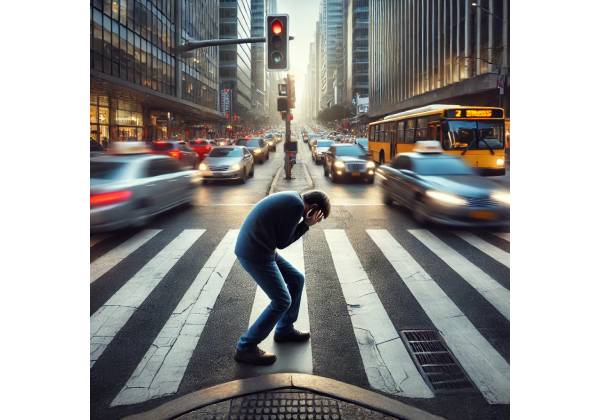What is agyrophobia?
Agyrophobia is an irrational fear of crossing streets, roads, or highways. While many people are cautious or anxious when navigating busy streets, those with agyrophobia experience intense fear or panic even in relatively safe situations. This phobia can be triggered by a fear of being hit by a vehicle, but it is frequently associated with a deeper sense of losing control or being overwhelmed in open spaces with moving cars. The term “agyrophobia” is derived from the Greek words “agyros,” meaning street, and “phobia,” which means fear.
Living with agyrophobia can present significant challenges in daily life, especially in urban areas where crossing streets is commonplace. Individuals may avoid walking in specific areas, take longer routes to avoid crossing streets, or experience severe anxiety when confronted with the situation. The condition can deteriorate, limiting personal mobility and independence.
While agyrophobia is a distinct phobia, it can coexist with other anxiety disorders, including agoraphobia and generalized anxiety disorder (GAD). Understanding this condition is critical for those suffering from it, as well as their loved ones, in order to seek appropriate treatment and learn effective coping strategies. This article will go into detail about agyrophobia, including its symptoms, causes, and the most effective treatments.
Symptoms of Agyrophobia
Agyrophobia causes both physical and psychological symptoms, which can have a significant impact on an individual’s quality of life. Recognizing these symptoms is critical for understanding how the phobia manifests itself and determining when professional help is required.
1. Physical Symptoms
Agyrophobia’s physical symptoms are often similar to those associated with panic attacks or increased anxiety. These symptoms usually appear when the individual is faced with the prospect of crossing a street or highway, but they can also occur in anticipation of such an event. Typical physical symptoms include:
- Rapid heartbeat (tachycardia): The body’s natural response to fear activates the fight-or-flight mechanism, causing the heart to race.
- Shortness of breath: When faced with the prospect of crossing a street, many people have difficulty breathing or feel suffocated.
- Dizziness or lightheadedness: As an individual’s anxiety level rises, they may experience dizziness or vertigo, making it difficult to navigate traffic safely.
- Sweating or chills: Anxiety can cause excessive sweating, especially in the palms, face, and underarms. Even in warm weather, some people report feeling chilled.
- Nausea or upset stomach: The fear response frequently affects the digestive system, resulting in nausea, stomach cramps, or upset stomach.
- Trembling or shaking: When anxiety peaks, the body may shake uncontrollably, especially the hands and legs.
- Chest pain or tightness: Extreme fear can cause chest discomfort or pain, which may be misinterpreted as a sign of a more serious medical problem, such as a heart attack.
These physical symptoms are frequently overwhelming, making it difficult for the person to perform the seemingly simple task of crossing a street. In severe cases, the symptoms can last long after the immediate situation is over, reinforcing the fear and avoidance behavior.
2. Emotional and Psychological Symptoms
Agyrophobia causes both emotional and psychological symptoms that are equally debilitating. Individuals may experience:
- Overwhelming fear or dread: Even if the situation is objectively safe, the thought of crossing a road can make you feel terrified. This fear may be irrational, but it is deeply embedded in the person’s psyche.
- Fear of losing control or being harmed: Many people with agyrophobia are afraid that they will lose control of the situation or be hit by a car or other vehicle. This feeling of vulnerability exacerbates their anxiety.
- Anticipatory anxiety: People may experience anxiety even before they need to cross a street. For example, the mere thought of leaving the house or encountering a congested road can cause stress and worry for days or even weeks in advance.
- Panic attacks: In severe cases, people may experience panic attacks when confronted with the need to cross the street. A panic attack is characterized by a rapid heart rate, chest pain, difficulty breathing, dizziness, and a sense of impending doom.
- Feelings of helplessness or embarrassment: Many people with agyrophobia are embarrassed about their fear, especially if it keeps them from participating in daily activities. This can cause feelings of helplessness or frustration.
3. Behavioral Symptoms
Individuals with agyrophobia frequently develop behavioral patterns in response to intense feelings of fear and anxiety. These patterns aim to avoid the situations that trigger the phobia. These behaviors include the following:
- Avoiding busy streets or highways: Many people will go to great lengths to avoid crossing streets, even if it means taking much longer routes or avoiding certain areas entirely.
- Reliance on others for assistance: Some people may refuse to cross the street unless accompanied by a trusted companion, such as a family member or close friend. This reliance can foster feelings of dependence and limit personal freedom.
- Using alternative transportation: To avoid walking and crossing streets, some people may rely on taxis or ridesharing services, even for short trips. This can increase financial stress and further limit independence.
- Over-preparation for street crossings: People with agyrophobia may overplan or conduct extensive research to reduce their exposure to street crossings. This could include taking routes that involve pedestrian bridges or waiting for long periods of time until traffic clears.
These behavioral adaptations can exacerbate the fear, making it more difficult for the individual to confront their phobia. This cycle of avoidance and anxiety can have a significant negative impact on an individual’s quality of life.
Causes and Risk Factors for Agyrophobia
Agyrophobia, like many other specific phobias, stems from a combination of genetic, psychological, and environmental factors. Understanding the underlying causes can help identify who is at risk and shed light on how the phobia develops.
1. Traumatic Experiences
One of the most common causes of agyrophobia is a previous traumatic experience with traffic or street crossings. This could include being involved in a pedestrian accident or witnessing a traumatic event like a car crash. Such incidents can leave a lasting impression on the individual’s mind, resulting in an irrational fear of crossing streets.
2. Learned Behavior
Agyrophobia can also result from learned behavior. Children, for example, who witness their parents’ fear of traffic or street crossings may develop similar fears. Individuals who are exposed to stories or media reports about pedestrian accidents may develop an increased fear of crossing streets, even if they have never personally witnessed such an event.
3. Underlying Anxiety Disorders
Agyrophobia is frequently associated with other anxiety disorders, such as generalized anxiety disorder (GAD) and social anxiety disorder. Individuals who are predisposed to anxiety are more likely to develop specific phobias, as their increased sensitivity to stress can lead to fear responses.
4. Genetic Predisposition
There is evidence that some people may have a genetic predisposition to developing phobias, such as agyrophobia. People with a family history of anxiety disorders or specific phobias are more likely to develop such conditions. This genetic vulnerability, when combined with environmental factors, can raise the risk of developing agyrophobia.
5. Cognitive biases
Many people with agyrophobia have cognitive distortions or biases that exacerbate their fear. For example, they may overestimate their chances of being hit by a car or underestimate their ability to safely cross a street. These distorted thoughts can exacerbate their anxiety and make the fear of crossing streets appear more rational in their minds.
How Agyrophobia is Diagnosed
To diagnose agyrophobia, a licensed mental health professional, such as a psychologist or psychiatrist, must conduct a comprehensive evaluation. The diagnostic process entails gathering detailed information about the person’s symptoms, anxiety history, and how the phobia affects their daily life.
1. Clinical Interview and Symptom Assessment
The mental health professional will conduct a clinical interview to learn about the individual’s experiences with street crossings and anxiety levels. Key questions could include:
- When did the fear begin: Knowing when the fear began and how it has progressed over time can aid in identifying potential triggers or traumatic experiences.
- Situations that cause anxiety: The individual is asked to describe specific situations that make them nervous, such as crossing busy intersections or walking near traffic.
- Physical and emotional symptoms: The clinician will evaluate the severity of the phobia’s physical and emotional symptoms, which may include panic attacks, dizziness, or feelings of dread.
2. Diagnostic criteria
Agyrophobia is classified as a specific phobia in the **Diagnostic and Statistical Manual of Mental Disorders (DSM-5). To meet the diagnostic criteria for agyrophobia, the person must:
- Experience intense fear or anxiety when crossing streets or highways.
- Avoid situations where street crossings are required, or tolerate them with extreme distress.
- Recognize that their fear is excessive or irrational, but are unable to control it.
- Have symptoms that last six months or longer and interfere with their daily activities.
3. Differential Diagnosis
The clinician may also perform a differential diagnosis to rule out other anxiety disorders that may produce similar symptoms. For example:
- Agoraphobia: People with agoraphobia may be afraid of public spaces or places where they believe they cannot escape, which may overlap with fears about street crossings. However, agoraphobia is a more general fear of crowds, open spaces, or unfamiliar environments, whereas agyrophobia is a fear of crossing streets or highways.
- Social anxiety disorder: Social anxiety is the fear of being judged or embarrassed in social situations, which can lead people to avoid busy streets. However, the primary fear in social anxiety disorder is social interaction rather than traffic or crossing the street.
- Panic disorder: If the individual has panic attacks in situations other than street crossings, it may be due to panic disorder rather than agyrophobia. Agyrophobia can cause panic attacks, but they are usually limited to the fear of traffic or crossing streets.
By distinguishing agyrophobia from other conditions, the clinician can devise a more precise and targeted treatment strategy.
The Effects of Agyrophobia on Daily Life
Agyrophobia can have a significant impact on many aspects of daily life, limiting one’s mobility, independence, and social interactions. The following are some important ways that agyrophobia affects everyday life:
1. Limited mobility and independence
Agyrophobia has a significant impact on personal mobility. Individuals with agyrophobia may avoid walking in cities or rely on others to accompany them when crossing the street. This avoidance can make it difficult for them to complete necessary tasks like going to work, running errands, or attending social events.
In severe cases, people may become completely reliant on others to navigate their surroundings. This loss of independence can cause feelings of frustration and helplessness because they are unable to move freely within their own community. It may also increase reliance on expensive alternatives, such as taxis or ridesharing services, reducing their financial independence.
2. Impact on Professional Life
Agyrophobia can also limit a person’s professional opportunities. Jobs that require commuting through congested urban areas, attending meetings across town, or traveling to multiple locations may be too much for someone with this phobia. Some people may decline job offers or promotions because they are afraid of navigating unfamiliar streets or highways.
Fear of crossing streets can also have an impact on work performance, especially if the individual is frequently late or unable to attend off-site meetings or events. Over time, this can limit career advancement and financial stability, adding stress to an already difficult situation.
3. Social Isolation
Agyrophobia can lead to social isolation because people avoid social activities that require crossing streets or traveling to specific locations. Simple outings with friends, such as going to a restaurant or attending a concert, can be stressful or impossible due to the fear of encountering congested roads.
This avoidance can strain relationships because friends and family may not understand the severity of the fear or its impact on the individual’s life. Over time, the individual may withdraw from all social interactions, resulting in feelings of loneliness and depression.
4. Mental and emotional toll
Living with agyrophobia can have a significant impact on an individual’s mental health. Constant anxiety and avoidance behaviors can lead to feelings of helplessness, low self-esteem, and a lack of confidence in their ability to navigate the world safely. Many people feel shame or embarrassment about their fear, especially if it keeps them from engaging in daily activities.
Fear of crossing the street can exacerbate other anxiety-related conditions, such as generalized anxiety disorder or depression, resulting in a vicious cycle of fear, avoidance, and emotional distress.
Treatment Alternatives for Agyrophobia
Fortunately, agyrophobia is a highly treatable condition, and many people can significantly improve their quality of life using a combination of therapies, self-help strategies, and, in some cases, medications. The following are some of the most effective treatments for agyrophobia.
1. Cognitive behavior therapy (CBT)
Cognitive Behavioral Therapy (CBT) is a highly effective treatment for agyrophobia. This evidence-based therapy focuses on identifying and challenging negative thought patterns that contribute to a fear of crossing streets. CBT assists individuals in recognizing their irrational thoughts, such as “I will be hit by a car” or “I cannot safely cross the street,” and replacing them with more rational, balanced perspectives.
Key components of CBT for agyrophobia are:
- Cognitive restructuring is the process of identifying and challenging distorted thoughts and beliefs about street crossings. The therapist assists the individual in questioning the likelihood of the feared outcome and developing healthier, more realistic perspectives on the situation.
- Exposure therapy: Exposure therapy is an essential component of CBT for treating phobias. The individual is gradually exposed to their fear in a controlled, step-by-step manner, beginning with less anxiety-provoking situations and progressing to more difficult environments, such as crossing a busy street. Repeated exposure helps the individual become desensitized to their fear, which reduces anxiety over time.
According to research, CBT, particularly when combined with exposure therapy, can significantly reduce anxiety and avoidance behaviors, allowing people to regain control of their lives.
2. Virtual reality therapy (VRT)
Virtual Reality Therapy (VRT) is a newer, innovative treatment option that allows people to confront their fear of crossing the street in a simulated, controlled setting. Individuals can use virtual reality headsets to experience street crossings and traffic without leaving the therapist’s office.
VRT is especially useful for people who are not yet ready to face real-world situations but want to learn how to manage their anxiety. As they gain confidence in the virtual environment, they can gradually progress to real-world exposures.
3. Medications
While therapy is the most effective long-term treatment for agyrophobia, medications may be prescribed to alleviate symptoms, particularly in severe cases. Common medications used to treat phobias are:
- Selective Serotonin Reuptake Inhibitors (SSRIs): These antidepressants regulate serotonin levels in the brain, thereby alleviating anxiety and panic symptoms. They are frequently prescribed to people who have severe anxiety or co-occurring conditions such as generalized anxiety disorder or depression.
- Benzodiazepines: These anti-anxiety medications are occasionally used for short-term relief of acute anxiety symptoms, such as before crossing a busy road. However, they are not recommended for long-term use due to the risk of addiction.
- Beta-blockers: These medications reduce the physical symptoms of anxiety, such as rapid heartbeat and trembling, by blocking the effects of adrenaline. They are commonly used in specific situations to alleviate panic symptoms.
Medications are commonly used in conjunction with therapy to treat both the symptoms and the underlying causes of the phobia.
4. Relaxation Techniques and Mindfulness
Relaxation techniques and mindfulness practices can be effective tools for dealing with the physical symptoms of agyrophobia. Deep breathing, progressive muscle relaxation, and guided visualization are all techniques that can help calm the body’s stress response and make it easier to deal with anxiety-provoking situations.
Mindfulness encourages people to stay in the present moment and observe their thoughts without judgment, which reduces anticipatory anxiety and helps them manage their fear more effectively.
5. Group Therapy and Support Networks
Participating in group therapy or support groups can help people with agyrophobia feel more connected and encouraged. Sharing experiences with others who face similar challenges can help reduce feelings of isolation and provide practical coping strategies.
Group therapy, led by a mental health professional, can also help people practice exposure in a safe environment, increasing their confidence and resilience in real-world situations.
6. Self-help Strategies
In addition to professional treatment, people with agyrophobia can use a variety of self-help strategies in their daily lives. This includes:
- Setting small, attainable goals: Gradually progress to more difficult street crossings, beginning with quiet streets and progressing to busier intersections.
- Tracking progress: Keeping a journal of successes and setbacks can help people identify patterns in their fears and track their progress over time.
- Establishing a support network: Having supportive friends or family members accompany the individual to street crossings can provide emotional support and encouragement.
Individuals suffering from agyrophobia can actively manage their condition and regain their independence by combining self-help strategies with professional treatment.











